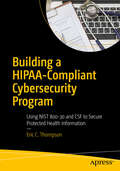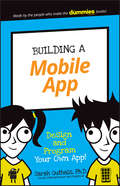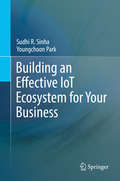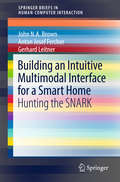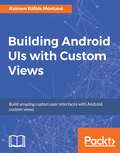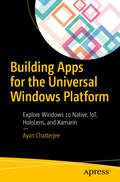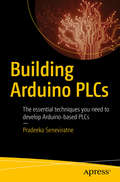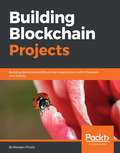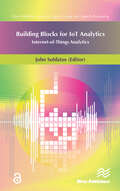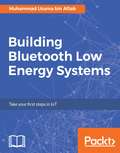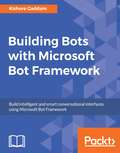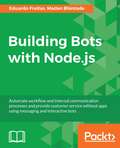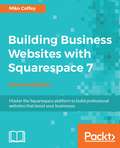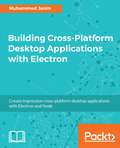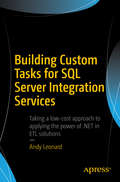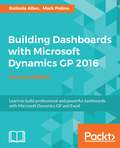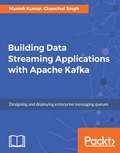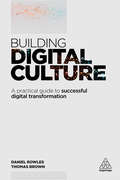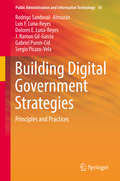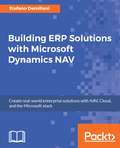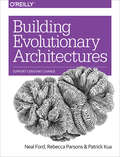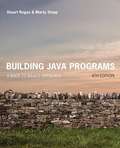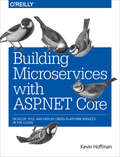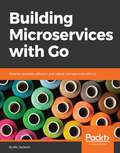- Table View
- List View
Building a Foundation with Microsoft Office 2016
by Alec Fehl Christie Jahn Hovey Ben Linford Dill MurphyBuilding a Foundation with Microsoft Office 2016
Building a HIPAA-Compliant Cybersecurity Program: Using NIST 800-30 and CSF to Secure Protected Health Information
by Eric C. ThompsonUse this book to learn how to conduct a timely and thorough Risk Analysis and Assessment documenting all risks to the confidentiality, integrity, and availability of electronic Protected Health Information (ePHI), which is a key component of the HIPAA Security Rule. The requirement is a focus area for the Department of Health and Human Services (HHS) Office for Civil Rights (OCR) during breach investigations and compliance audits. This book lays out a plan for healthcare organizations of all types to successfully comply with these requirements and use the output to build upon the cybersecurity program. With the proliferation of cybersecurity breaches, the number of healthcare providers, payers, and business associates investigated by the OCR has risen significantly. It is not unusual for additional penalties to be levied when victims of breaches cannot demonstrate that an enterprise-wide risk assessment exists, comprehensive enough to document all of the risks to ePHI. Why is it that so many covered entities and business associates fail to comply with this fundamental safeguard? Building a HIPAA Compliant Cybersecurity Program cuts through the confusion and ambiguity of regulatory requirements and provides detailed guidance to help readers: Understand and document all known instances where patient data exist Know what regulators want and expect from the risk analysis process Assess and analyze the level of severity that each risk poses to ePHI Focus on the beneficial outcomes of the process: understanding real risks, and optimizing deployment of resources and alignment with business objectives What You'll Learn Use NIST 800-30 to execute a risk analysis and assessment, which meets the expectations of regulators such as the Office for Civil Rights (OCR) Understand why this is not just a compliance exercise, but a way to take back control of protecting ePHI Leverage the risk analysis process to improve your cybersecurity program Know the value of integrating technical assessments to further define risk management activities Employ an iterative process that continuously assesses the environment to identify improvement opportunities Who This Book Is For Cybersecurity, privacy, and compliance professionals working for organizations responsible for creating, maintaining, storing, and protecting patient information
Building a Mobile App: Design and Program Your Own App!
by Sarah GuthalsCoding is cool, and these fun projects help you get started today! Building a Mobile App offers basic lessons in Android development, designed specifically for kids! Three fun projects walk you through basic coding skills using MIT's App Inventor—a free, online programming tool that uses a simple block style language that makes coding easy to learn. No long chapters to read, and no homework—just dive right in! You'll begin with a basic project that shows you how to make an app that works; next, you'll put those skills to work on a photo editing app that takes your skills to the next level. Finally, you'll level up one more time to become a Game Maker—that's right, you'll actually build a mobile game that you can send to your friends! Each project includes step-by-step directions and plenty of graphics to help you stay on track, and easy-to-read instructions help you complete each project frustration-free. App building can get pretty complicated, but it doesn't have to start out that way. Start small to pick up the basics quickly, and you'll be coding in no time! This book helps you get started quickly and easily, with a focus on fun. Build your own Android mobile apps using a free online platform! Code everything yourself, including buttons, screens, and interactions! Build an app that lets you draw on pictures you take! Create a simple, interactive game you can share with your friends! Adults all over the world turn to For Dummies books for clear instruction with a sense of humor; the Dummies Junior books bring that same "learning is fun" attitude to kids, with projects designed specifically for a kid's interests, needs, and skill level. Building a Mobile App gets kids coding quickly, with fun projects they'll be happy to show off!
Building an Effective IoT Ecosystem for Your Business
by Sudhi R. Sinha Youngchoon ParkThis descriptive, practical guide explains how to build a commercially impactful, operationally effective and technically robust IoT ecosystem that takes advantage of the IoT revolution and drives business growth in the consumer IoT as well as industrial internet spaces. With this book, executives, business managers, developers and decision-makers are given the tools to make more informed decisions about IoT solution development, partner eco-system design, and the monetization of products and services. Security and privacy issues are also addressed. Readers will explore the design guidelines and technology choices required to build commercially viable IoT solutions, but also uncover the various monetization and business modeling for connected products.
Building an Intuitive Multimodal Interface for a Smart Home: Hunting the SNARK (Human–Computer Interaction Series)
by Gerhard Leitner John N.A Brown Anton Josef FercherThis book describes an innovative approach to the interaction between humans and a smart environment; an attempt to get a smart home to understand intuitive, multi-modal, human-centred communication. State of the art smart homes, like other "smart" technology, tend to demand that the human user must adapt herself to the needs of the system. The hunt for a truly user-centred, truly intuitive system has long proven to be beyond the grasp of current technology. When humans speak with one another, we are multimodal. Our speech is supplemented with gestures, which serve as a parallel stream of information, reinforcing the meaning of our words. Drawing on well-established protocols in engineering and psychology, and with no small amount of inspiration from a particular nonsense poem, we have successfully concluded that hunt. This book describes the efforts, undertaken over several years, to design, implement, and test a model of interaction that allows untrained individuals to intuitively control a complex series of networked and embedded systems. The theoretical concepts are supported by a series of experimental studies, showing the advantages of the novel approach, and pointing towards future work that would facilitate the deployment of this concept in the real world.
Building Android UIs with Custom Views
by Raimon Rafols MontaneCreate engaging user experiences and awesome user interfaces using this guide About This Book • Move beyond default UI templates, create and customize amazing UIs with Android Custom View • Enable smooth data flow and create futuristic UIs by creating flexible custom views • Scale your apps with responsive and data intensive views Who This Book Is For This book is for Android developers who want to create great user interfaces and move beyond the basics of the standard UI elements. They must have basic Android development knowledge along with basic Java programming. What You Will Learn • Extend the standard UI widget framework by creating Custom views • Add complex rendering, animations, and interactions to your views • Optimize performance and decrease battery usage • Implement custom views to share between multiple projects, or share it publicly • Create 3D custom views using OpenGL ES In Detail To build great user interfaces for your Android apps that go beyond the standard UI elements, you need to use custom Android views. With these, you can give your app a distinctive look and ensure that it functions properly across multiple devices. This book will help you construct a great UI for your apps by teaching you how to create custom Android views. You will start by creating your first Android custom view and go through the design considerations. You will then see how the right choices will enable your custom view to perform seamlessly across multiple platforms and Android versions. You will create custom styleable attributes that work with Android XML layouts, learn to process touch events, define custom attributes, and add properties and events to them. By the end of this book, you will be able to create apps with custom views that are responsive and adaptable to make your app distinctive and an instant hit with its users. Style and approach The approach will be that of a step by step practical tutorial. The book will take you through a complete journey, right from creating your first Android view to customizing it to enable it to support any complex app.
Building Apps for the Universal Windows Platform: Explore Windows 10 Native, IoT, HoloLens, and Xamarin
by Ayan ChatterjeeDevelop Windows 10 applications faster and more efficiently using the Universal Windows Platform. You will use Xamarin to create apps for macOS, iOS, and Android devices. Building Apps for the Universal Windows Platform is a complete guide covering PCs, tablets, phones, and other devices such as HoloLens. You will use Windows 10 to develop apps for desktop, mobile, holographic, wearable, and IoT devices. You will reuse code to easily create cross-platform apps. What You Will Learn Design and develop apps using Visual Studio and Blend Create Cortana-enabled apps for a hands-free experience Build IoT apps and apps for wearables such as the Microsoft HoloLens Monitor apps post-publication to gain insights from actionable data using Windows Store Analytics and Azure Who This Book Is For Professional developers working independently or in a team on Windows 10 applications, and students coming into the world of software development
Building Arduino PLCs: The essential techniques you need to develop Arduino-based PLCs
by Pradeeka SeneviratneLearn the fundamentals of PLCs and how to control them using Arduino software to create your first Arduino PLC. You will learn how to draw Ladder Logic diagrams to represent PLC designs for a wide variety of automated applications and to convert the diagrams to Arduino sketches. A comprehensive shopping guide includes the hardware and software components you need in your tool box. You will learn to use Arduino UNO, Arduino Ethernet shield, and Arduino WiFi shield. Building Arduino PLCs shows you how to build and test a simple Arduino UNO-based 5V DC logic level PLC with Grove Base shield by connecting simple sensors and actuators. You will also learn how to build industry-grade PLCs with the help of ArduiBox. What You'll Learn Build ModBus-enabled PLCs Map Arduino PLCs into the cloud using NearBus cloud connector to control the PLC through the Internet Use do-it-yourself light platforms such as IFTTT Enhance your PLC by adding Relay shields for connecting heavy loads Who This Book Is For Engineers, designers, crafters, and makers. Basic knowledge in electronics and Arduino programming or any other programming language is recommended.
Building Blockchain Projects
by Narayan PrustyThis book is for JavaScript developers who now want to create tamper-proof data (and transaction) applications using Blockchain and Ethereum. Those who are interested in cryptocurrencies and the logic and database empowering it will find this book extremely useful.
Building Blocks for IoT Analytics Internet-of-Things Analytics
by John SoldatosInternet-of-Things (IoT) Analytics are an integral element of most IoT applications, as it provides the means to extract knowledge, drive actuation services and optimize decision making. IoT analytics will be a major contributor to IoT business value in the coming years, as it will enable organizations to process and fully leverage large amounts of IoT data, which are nowadays largely underutilized. The Building Blocks of IoT Analytics is devoted to the presentation the main technology building blocks that comprise advanced IoT analytics systems. It introduces IoT analytics as a special case of BigData analytics and accordingly presents leading edge technologies that can be deployed in order to successfully confront the main challenges of IoT analytics applications. Special emphasis is paid in the presentation of technologies for IoT streaming and semantic interoperability across diverse IoT streams. Furthermore, the role of cloud computing and BigData technologies in IoT analytics are presented, along with practical tools for implementing, deploying and operating non-trivial IoT applications. Along with the main building blocks of IoT analytics systems and applications, the book presents a series of practical applications, which illustrate the use of these technologies in the scope of pragmatic applications. Technical topics discussed in the book include: Cloud Computing and BigData for IoT analyticsSearching the Internet of ThingsDevelopment Tools for IoT Analytics ApplicationsIoT Analytics-as-a-ServiceSemantic Modelling and Reasoning for IoT AnalyticsIoT analytics for Smart BuildingsIoT analytics for Smart CitiesOperationalization of IoT analyticsEthical aspects of IoT analyticsThis book contains both research oriented and applied articles on IoT analytics, including several articles reflecting work undertaken in the scope of recent European Commission funded projects in the scope of the FP7 and H2020 programmes. These articles present results of these projects on IoT analytics platforms and applications. Even though several articles have been contributed by different authors, they are structured in a well thought order that facilitates the reader either to follow the evolution of the book or to focus on specific topics depending on his/her background and interest in IoT and IoT analytics technologies. The compilation of these articles in this edited volume has been largely motivated by the close collaboration of the co-authors in the scope of working groups and IoT events organized by the Internet-of-Things Research Cluster (IERC), which is currently a part of EU's Alliance for Internet of Things Innovation (AIOTI).
Building Bluetooth Low Energy Systems
by Muhammad Usama AftabDiscover and implement a system of your choice using Bluetooth Low Energy. About This Book • Learn the basics of Bluetooth Low Energy with its exciting new protocol stack and security. • Build customized Bluetooth Low Energy projects that make your web or mobile apps smarter in terms of networking and communications. • Using Android, iOS, and the Web, acquire key skills to harness the power of Bluetooth Low Energy in your IoT applications. Who This Book Is For The book is for developers and enthusiasts who are passionate about learning Bluetooth Low Energy technologies and want to add new features and services to their new or existing products. They should be familiar with programming languages such as Swift, Java, and JavaScript. Knowledge of debugging skills would be an advantage. What You Will Learn • Bluetooth Low Energy in theory. • Bluetooth Low Energy Hardware and Software Development Kits. • Implement Bluetooth low energy communication (central and peripheral) using Android. • Master BLE Beacons with examples implemented over Eddystone and iBeacons. • Implement indoor navigation using Estimote Beacons on iOS. • Implement Internet gateways to control BLE devices on a Wi-Fi network. • Understand BLE security mechanisms with a special focus on Bluetooth pairing, bonding, and key exchange to cover encryption, privacy, and user data integrity. • Implement Bluetooth Mesh using CSRMesh Technology. In Detail Bluetooth Low Energy (BLE) is a Wireless Personal Area network technology aimed at novel applications for smart devices. High-tech BLE profiles and services are being increasingly used by application developers and hardware enthusiasts to allow devices to interact with the surrounding world. This book will focus on a technical introduction to BLE and how it is reshaping small-distance communication. We will start with IoT, where many technologies such as BLE, Zigbee, and IEEE 802.15.4 Mesh will be introduced. The book will present BLE from an engineering perspective, from which the protocol stack, architecture, and layers are discussed. You will learn to implement customized projects for Peripheral/Central communication, BLE Beacons, indoor navigation using triangulation, and the Internet gateway for Bluetooth Low Energy Personal Network, all using various code samples and APIs on Android, iOS, and the Web. Finally, the book will conclude with a glimpse into future technologies destined to be prominent in years to come. Style and approach The book is a practical tutorial that will help you understand the background and technicalities of BLE and offers a friendly environment to build and create robust BLE projects. This hands-on approach will give you a clear vision of Bluetooth Low Energy and how it can be used in IoT.
Building Bots with Microsoft Bot Framework
by Kishore GaddamThis book is for developers who are keen on building powerful services with great and interactive bot interface. Experience with C# is needed
Building Bots with Node.js
by Madan Bhintade Eduardo FreitasAutomate workflow and internal communication processes and provide customer service without apps using messaging and interactive bots About This Book • Create interactive bots on platforms such as Facebook Messenger, Kik, Telegram, and Skype to automate workflows • Create a bot that works with SQL Server and Skype to deal with HR requests within a company • Work with some of the most cutting-edge and widely-used APIs and messaging platforms to create interactive customer-facing experiences and automate work Who This Book Is For This is a book for Node.js developers who want to build powerful bots for customer-facing and internal workflow automation. What You Will Learn • Create a bot template that responds to e-mails based on certain ruling criteria • Interact with SMS and perform some basic Natural Language Processing using the Twilio API for Node.js • Work with the Skype Web SDK and Node.js to create a bot that works with SQL Server and Skype • Build an automated Flight Information Agent bot using the Twitter and Air France KLM APIs • Create a scheduling bot for teams using the Facebook Messenger API • Interact with BotKit along with and MongoDB Amazon S3 to create a document management bot in Node.js • Leverage ICR and Azure Table Storage from Node.js to create a bug tracking bot • Integrate Force.com API and Kik to create a Salesforce CRM bot In Detail The bots are taking over and we're all for it! Messenger-based bots will be the dominant software UI for the next generation of applications – even Slack, Telegram, and Facebook are driving a new approach where "threads are the new apps." This book shows you how to create work automation bots that interact with users through Slack, e-mail, Skype, Twitter, and more using Node.js. You'll learn to create conversational UIs for your Node.js apps, and then use those UIs to provide workflow automation tools. You will be shown how to handle customer service requests that come in through messenger systems – this includes interpreting the natural language to reveal the user's intent and respond accordingly. You will also learn how to automate processes that involve several people, such as processing holiday requests, arranging meetings, or sending updated reports on time. By the end of this book you'll have the knowledge to create bots that can handle and manipulate documents, URLs, and other items of content. Harness the power of bots and your organization will reap the benefits. Style and approach This fast-paced book is packed with real-world use cases that will help you understand concepts, issues, and solutions while using Node.js to build useful, cross-platform business bots.
Building Business Websites with Squarespace 7 - Second Edition
by Miko CoffeyDiscover the best way to build, design and launch professional websites with Squarespace quickly, without needing to learn any code About This Book • Discover time-saving tricks and best practices, and avoid common pitfalls while creating a website • Create visually stunning Responsive Design templates for your website with Squarespace 7 • Understand how to monitor, measure, and manage your website after launching it Who This Book Is For This book is ideal for anyone who wants to learn how to use the latest version of Squarespace to create a website from scratch and take it through to go-live. You don't need any prior experience with Squarespace, HTML, or CSS, or building websites in general as everything is done using Squarespace's simple, browser-based interface. What You Will Learn • Develop an essential Website Toolkit that will act as reference and materials for your entire project, ensuring you stay on-target to meet your objectives • Set up your Squarespace account, learn how the interface works, and select the correct template for your website's purpose and goals • Create your website framework, fill it with content, and arrange your pages using Squarespace's easy drag-and-drop tools • Customize your site's look and feel to match your brand, and create a stunning visual impact for your website on all types of devices, including mobiles and tablets • Configure the core functions your business needs, whether connecting to social media, promoting events, showcasing your work, or selling goods and services online • Learn time-saving tricks and how to avoid common pitfalls from an experienced professional with years of Squarespace experience • Gain valuable insights about search engine optimization, communicating effectively online, and other e-marketing advice • How to monitor, measure, and manage your website post-launch In Detail Squarespace is a web-based tool that allows non-technical people to create and manage professional-looking websites quickly, without needing to write any code. It empowers business owners to take total control of their own websites, without needing to pay someone to design or maintain it. This book covers much more than just how to use Squarespace. It covers all aspects of creating a successful business website, from developing your brand identity, to writing and structuring content to match your target audience's needs, and dozens of other other valuable tips that will help your website shine. Most importantly, you'll learn the correct steps to follow in order to ensure your project is smooth and stress-free. The book starts by helping you plan your website project and gather all the raw materials you'll need. Next, you'll set up your account and become familiar with the terminology and tools that you'll be using. Once you've learned the basics of how the Squarespace interface, templates, and different page types operate, you will create the framework of your website, ready for you to insert content and functionality. Then, once all the core elements are in place, you'll apply the aesthetic fine-tuning needed to bring your website in line with your brand. After the aesthetics have been honed and all functions tested, you will launch your website and drive traffic to it, monitor it, and improve it. Style and approach This easy-to-follow guide will teach you to build websites the easiest way in the latest version of Squarespace.
Building Cross-Platform Desktop Applications with Electron
by Muhammed JasimLearn how to develop cross-platform desktop app from scratch with Electron and Node About This Book • Build a solid foundation with Electron for an easier development experience • Use modern JavaScript frameworks and tools along with Electron to take your desktop applications to the next level • Extend the functionality of Electron through modules Who This Book Is For If you are a developer with prior experience of building front-end applications and you are keen on developing a cross-platform desktop application, then this book is for you. This book is also ideal for experienced JavaScript developers with a basic understanding of front-end development and Node.js development. What You Will Learn • Explore various tools and libraries to build and debug an Electron application • Use popular JavaScript frameworks such as Angular and Typescript along with Electron to enhance your app • Work with the desktop UI development for Electron using Photon • Find out how to use various Electron APIs like Clipboard, Process, Shell, Image, File, Session, and Cookie • Integrate your application into different desktop environments with Electron API • Cache your network resources using service worker • Test the Electron application using Mocha and Spectron • See how to package and distribute an Electron application In Detail Though web applications are becoming increasingly popular, desktop apps are still important. The Electron framework lets you write cross-platform desktop applications using JavaScript, HTML, and CSS, and this book will teach you how to create your first desktop application with Electron. It will guide you on how to build desktop applications that run on Windows, Mac, and Linux platforms. You will begin your journey with an overview of Electron, and then move on to explore the various stages of creating a simple social media application. Along the way, you will learn how to use advanced Electron APIs, debug an Electron application, and make performance improvements using the Chrome developer tools. You'll also find out how to package and distribute an application, and more. By the end of the book, you will be able to build a complete desktop application using Electron and web technologies. You will have a solid understanding of the common challenges that desktop app developers face, and you'll know how to solve them. Style and approach Covers everything you need to know about Electron with full examples and explanations to get you building desktop apps with Electron as quickly as possible.
Building Custom Tasks for SQL Server Integration Services
by Andy LeonardLearn to build custom SSIS tasks using Visual Studio Community Edition and Visual Basic. Bring all the power of Microsoft . NET to bear on your data integration and ETL processes, and for no added cost over what you've already spent on licensing SQL Server. If you already have a license for SQL Server, then you do not need to spend more money to extend SSIS with custom tasks and components. Why are custom components necessary? Because even though the SSIS catalog of built-in tasks and components is a marvel of engineering, there do remain gaps in the functionality that is provided. These gaps are especially relevant to enterprises practicing Data Integration Lifecycle Management (DILMS) and/or DevOps. One of the gaps is a limitation of the SSIS Execute Package task. Developers using the stock version of that task are unable to select SSIS packages from other projects. Yet it's useful to be able to select and execute tasks across projects, and the example used throughout this book will help you to create an Execute Catalog Package task that does in fact allow you to execute a task from another project. Building on the example's pattern, you can create any task that you like, custom tailored to your specific, data integration and ETL needs. What You Will Learn Configure and execute Visual Studio in the way that best supports SSIS task development Create a class library as the basis for an SSIS task, and reference the needed SSIS assemblies Properly sign assemblies that you create in order to invoke them from your task Implement source code control via Visual Studio Team Services, or your own favorite tool set Code not only your tasks themselves, but also the associated task editors Troubleshoot and then execute your custom tasks as part of your own project Who This Book Is For Database administrators and developers who are involved in ETL projects built around SQL Server Integration Services (SSIS). Readers should have a background in programming along with a desire to optimize their ETL efforts by creating custom-tailored tasks for execution from SSIS packages.
Building Dashboards with Microsoft Dynamics GP 2016 - Second Edition
by Mark Polino Belinda AllenLearn to build professional and powerful dashboards with Microsoft Dynamics GP and Excel About This Book • This book provides a core foundation for you to understand the ever-changing Microsoft Power BI • Through this book, you'll understand how data flows and is secured between Microsoft Dynamics GP and Microsoft Excel • You'll see how to create amazing dashboards using various tools such as Excel 2016, Power BI, Jet Express, and more Who This Book Is For This book is geared up for analysts and accountants keen on building and maintaining professional dashboards with Microsoft Excel 2016 for Microsoft Dynamics GP 2016 data, and building financials with visuals using the New Jet Reports Express Tool for Dynamics GP. An introduction is provided for those who want to maintain dashboards in Microsoft Power BI. What You Will Learn • Use GP Data in Excel 2016 in a meaningful way • Build basic financial statements using Jet Reporting Express, including visualizations • Understand the foundation of Power BI and its components • Get and maintain data from Dynamics GP in Power BI • Find out how to use the Power BI Query Editor (the Get and Transform feature in Excel 2016) • Format basic visualizations to get better insights • Understand Jet Reports Express, which is used to create basic financial statements • Use the new Dynamics GP features, such as OData and adding Power BI tiles on the home page In Detail Microsoft Dynamics GP is a complete ERP solution that is extremely beneficial for small to midsize organizations in helping them grow exponentially. The book shows you in detail how to build great-looking dashboards with Microsoft Dynamics GP that enhance a company's decision-making processes. This guide will take you from the basics of setting up and deploying to creating secure, refreshable Excel reports. Using a whole host of tools available within Microsoft Dynamics GP and Excel, this tutorial will show you how to visualize your data using simple conditional formatting techniques and easy-to-read charts, and allow you to make your data interactive with slicers. We will also cover core topics such as Business Analyzer, Microsoft SQL Reporting services reports, BI360, and more. You will find out to use Power BI, share and refresh data and dashboards in Power BI, and use Power BI Query Editor. By the end of this book, you will have all the information required to build interactive dashboards using Dynamics GP. Style and approach The book takes a step-by-step approach and contains real-world examples that provide the building blocks to create engaging dashboards. This practical guide is all about doing. Get your data, open up Excel, and go!
Building Data Streaming Applications with Apache Kafka
by Chanchal Singh Manish KumarDesign and administer fast, reliable enterprise messaging systems with Apache Kafka About This Book • Build efficient real-time streaming applications in Apache Kafka to process data streams of data • Master the core Kafka APIs to set up Apache Kafka clusters and start writing message producers and consumers • A comprehensive guide to help you get a solid grasp of the Apache Kafka concepts in Apache Kafka with pracitcalpractical examples Who This Book Is For If you want to learn how to use Apache Kafka and the different tools in the Kafka ecosystem in the easiest possible manner, this book is for you. Some programming experience with Java is required to get the most out of this book What You Will Learn • Learn the basics of Apache Kafka from scratch • Use the basic building blocks of a streaming application • Design effective streaming applications with Kafka using Spark, Storm &, and Heron • Understand the importance of a low -latency , high- throughput, and fault-tolerant messaging system • Make effective capacity planning while deploying your Kafka Application • Understand and implement the best security practices In Detail Apache Kafka is a popular distributed streaming platform that acts as a messaging queue or an enterprise messaging system. It lets you publish and subscribe to a stream of records, and process them in a fault-tolerant way as they occur. This book is a comprehensive guide to designing and architecting enterprise-grade streaming applications using Apache Kafka and other big data tools. It includes best practices for building such applications, and tackles some common challenges such as how to use Kafka efficiently and handle high data volumes with ease. This book first takes you through understanding the type messaging system and then provides a thorough introduction to Apache Kafka and its internal details. The second part of the book takes you through designing streaming application using various frameworks and tools such as Apache Spark, Apache Storm, and more. Once you grasp the basics, we will take you through more advanced concepts in Apache Kafka such as capacity planning and security. By the end of this book, you will have all the information you need to be comfortable with using Apache Kafka, and to design efficient streaming data applications with it. Style and approach A step-by –step, comprehensive guide filled with practical and real- world examples
Building Digital Culture: A Practical Guide to Successful Digital Transformation
by Daniel Rowles Thomas BrownBuilding Digital Culture aims to answer a simple question: How can organisations succeed when the environment they operate in is changing so quickly? The last thing businesses need today is a digital strategy. Instead, their strategy needs to be fit for our fast-changing digital world, where businesses have more data than they know what to do with, a media landscape that's exploded in size and complexity, the risk of a new disruption around every corner, and only one certainty: that this change won't let up.Building Digital Culture doesn't address whether or not you should advertise on Facebook or invest in virtual reality. It doesn't seek to unearth a silver bullet to make digital investments a sure-thing. It steps back from the hype, and argues that whatever digital might mean for your business, if you don't create a digital culture you'll most likely fail, or at least fall short of what you want to achieve.Daniel Rowles and Thomas Brown combine more than 30 years of experience at the forefront of marketing and digital developments to help you to navigate from being a business that tolerates or acts digital, to one that truly is digital.Building Digital Culture is based on more than 200 hours of research, candid interviews and contributions from senior leaders at a diverse range of brands including Twitter, Made.com, Tech London Advocates, Deloitte, HSBC, Reckitt Benckiser, Ladbrokes, Direct Line Group, The Metropolitan Police, Zurich Insurance and many more.
Building Digital Government Strategies: Principles and Practices (Public Administration and Information Technology #16)
by J. Ramon Gil-Garcia Luis F. Luna-Reyes Rodrigo Sandoval-Almazán Dolores E. Luna-Reyes Gabriel Puron-Cid Sergio Picazo-VelaThis book provides key strategic principles and best practices to guide the design and implementation of digital government strategies. It provides a series of recommendations and findings to think about IT applications in government as a platform for information, services and collaboration, and strategies to avoid identified pitfalls. Digital government research suggests that information technologies have the potential to generate immense public value and transform the relationships between governments, citizens, businesses and other stakeholders. However, developing innovative and high impact solutions for citizens hinges on the development of strategic institutional, organizational and technical capabilities. Thus far, particular characteristics and problems of the public sector organization promote the development of poorly integrated and difficult to maintain applications. For example, governments maintain separate applications for open data, transparency, and public services, leading to duplication of efforts and a waste of resources. The costs associated with maintaining such sets of poorly integrated systems may limit the use of resources to future projects and innovation. This book provides best practices and recommendations based on extensive research in both Mexico and the United States on how governments can develop a digital government strategy for creating public value, how to finance digital innovation in the public sector, how to building successful collaboration networks and foster citizen engagement, and how to correctly implement open government projects and open data. It will be of interest to researchers, practitioners, students, and public sector IT professionals that work in the design and implementation of technology-based projects and programs.
Building ERP Solutions with Microsoft Dynamics NAV
by Stefano DemilianiCreate real-world enterprise solutions with NAV, Cloud, and the Microsoft stack About This Book • Integrate NAV with various offerings of the Microsoft stack to create enterprise-ready and service-oriented solutions • Use Power BI and Universal Windows Platform for effective data analysis and real-time tracking with NAV • Discover the services offered by Microsoft Azure and implement them in different industries using real-world case scenarios Who This Book Is For This book is for NAV developers and solution architects who need to implement real-world enterprise solutions based on Microsoft Dynamics NAV. Knowledge of the NAV programming language (C/AL) and C# language is recommended. Knowledge of ASP.NET and Visual Studio development would help, but is not necessary. What You Will Learn • Configure NAV Web Services and create external applications with Visual Studio, .NET, and .NET Core • Solve technical architectural problems by implementing enterprise solutions with NAV • Develop applications and solutions with Microsoft Dynamics NAV and the Microsoft technology stack • Create a Power BI dashboard for rich reporting and NAV data analysis • Find out how to transmit your device location from a UWP application to NAV in order to implement a distributed solution for managing couriers in a sales company • Make the most of Microsoft Azure and its services • Create enterprise solutions with NAV by using Azure App Service • Use Azure Service Bus for managing distributed NAV applications In Detail Implementing Microsoft Dynamics NAV in the real world often requires you to integrate the ERP with external applications or solve complex architectural tasks in order to have a final successful project. This book will show you how to extend a Microsoft Dynamics NAV installation to the enterprise world in a practical way. The book starts with an introduction to Microsoft Dynamics NAV architecture and then moves on to advanced topics related to implementing real-world solutions based on NAV and external applications. You will learn how an enterprise distributed architecture with NAV at the core can be implemented. Through a series of real-world cases on every topic and every industry (sales, retail, manufacturing, distribution, healthcare, and so on), you'll see step by step how to efficiently solve a technical problem. These common problems encountered in a NAV implementation will be solved using the entire technology stack that Microsoft offers. By the end of the book, you will have the knowledge to efficiently solve certain scenarios, you will know which is the best solution architecture to propose to a customer and how to implement it. Style and approach Taking you through a variety of real-world use cases, the book will show you step by step all you need to know to tackle these problems and give you creative ideas to implement in related problems you might come across in the real world.
Building Evolutionary Architectures: Support Constant Change
by Neal Ford Rebecca Parsons Patrick KuaThe software development ecosystem is constantly changing, providing a constant stream of new tools, frameworks, techniques, and paradigms. Over the past few years, incremental developments in core engineering practices for software development have created the foundations for rethinking how architecture changes over time, along with ways to protect important architectural characteristics as it evolves. This practical guide ties those parts together with a new way to think about architecture and time.
Building Java Programs: A Back to Basics Approach
by Stuart Reges Marty SteppThe authors' proven and class-tested "back to basics" approach introduces programming fundamentals first, with new syntax and concepts added over multiple chapters, and object-oriented programming discussed only once readers have developed a basic understanding of Java programming.
Building Microservices with ASP.NET Core: Develop, Test, and Deploy Cross-Platform Services in the Cloud
by Kevin HoffmanAt a time when nearly every vertical, regardless of domain, seems to need software running in the cloud to make money, microservices provide the agility and drastically reduced time to market you require. This hands-on guide shows you how to create, test, compile, and deploy microservices, using the ASP.NET Core free and open-source framework. Along the way, you’ll pick up good, practical habits for building powerful and robust services.Building microservices isn’t about learning a specific framework or programming language; it’s about building applications that thrive in elastically scaling environments that don't have host affinity, and that can start and stop at a moment’s notice. This practical book guides you through the process.Learn test-driven and API-first development conceptsCommunicate with other services by creating and consuming backing services such as databases and queuesBuild a microservice that depends on an external data sourceLearn about event sourcing, the event-centric approach to persistenceUse ASP.NET Core to build web applications designed to thrive in the cloudBuild a service that consumes, or is consumed by, other servicesCreate services and applications that accept external configurationExplore ways to secure ASP.NET Core microservices and applications
Building Microservices with Go
by Nic JacksonYour one-stop guide to the common patterns and practices, showing you how to apply these using the Go programming language About This Book • This short, concise, and practical guide is packed with real-world examples of building microservices with Go • It is easy to read and will benefit smaller teams who want to extend the functionality of their existing systems • Using this practical approach will save your money in terms of maintaining a monolithic architecture and demonstrate capabilities in ease of use Who This Book Is For You should have a working knowledge of programming in Go, including writing and compiling basic applications. However, no knowledge of RESTful architecture, microservices, or web services is expected. If you are looking to apply techniques to your own projects, taking your first steps into microservice architecture, this book is for you. What You Will Learn • Plan a microservice architecture and design a microservice • Write a microservice with a RESTful API and a database • Understand the common idioms and common patterns in microservices architecture • Leverage tools and automation that helps microservices become horizontally scalable • Get a grounding in containerization with Docker and Docker-Compose, which will greatly accelerate your development lifecycle • Manage and secure Microservices at scale with monitoring, logging, service discovery, and automation • Test microservices and integrate API tests in Go In Detail Microservice architecture is sweeping the world as the de facto pattern to build web-based applications. Golang is a language particularly well suited to building them. Its strong community, encouragement of idiomatic style, and statically-linked binary artifacts make integrating it with other technologies and managing microservices at scale consistent and intuitive. This book will teach you the common patterns and practices, showing you how to apply these using the Go programming language. It will teach you the fundamental concepts of architectural design and RESTful communication, and show you patterns that provide manageable code that is supportable in development and at scale in production. We will provide you with examples on how to put these concepts and patterns into practice with Go. Whether you are planning a new application or working in an existing monolith, this book will explain and illustrate with practical examples how teams of all sizes can start solving problems with microservices. It will help you understand Docker and Docker-Compose and how it can be used to isolate microservice dependencies and build environments. We finish off by showing you various techniques to monitor, test, and secure your microservices. By the end, you will know the benefits of system resilience of a microservice and the advantages of Go stack. Style and approach The step-by-step tutorial focuses on building microservices. Each chapter expands upon the previous one, teaching you the main skills and techniques required to be a successful microservice practitioner.

